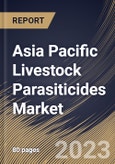The demand for cattle parasiticides has been shown to expand in recent years due to increased awareness of and worries about diseases brought on by parasites, bacteria, fungi, and viruses. Due to the expanding market for livestock parasiticides and the increasing demand for potent medications, the top market players have made substantial investments in the livestock parasiticides market. Additionally, it is a key factor in the animal health sector's increased R&D efforts.
The leading market players are also concentrating on growing their worldwide footprint by setting up R&D centers and manufacturing facilities and through acquisitions of market players as well as partnerships and agreements in these fast-growing marketplaces. Because of their unpredictability, ability to appear anywhere, and quick global dissemination, zoonotic diseases are a major source of concern. Zoonotic spread is influenced by climate seasonality and weather factors like humidity, pressure, wind speed, and direction.
The variety of bacteria and viruses to which animals may be exposed has expanded due to climate change, as have the number of capable vectors and recipient species. Veterinary doctors and hospital staff can benefit from using livestock parasiticides to treat zoonotic infections. The major players provide livestock parasiticides and are working to create value-added features such as efficient sprays, dips, collars, etc. Growing concerns about zoonotic illnesses are caused by increased livestock farms and the demand for meat & animal by-products on the market.
In various countries, including India, China, and Japan, various regulatory organizations have been set up to guarantee animal safety. For example, a specialized national PV Programme of India (PvPI) has been formed in India by the Ministry of Health and Family Welfare (MoHFW) to monitor the security of medicines. Animal medicines must be carefully evaluated for their immediate, long-term, and environmental effects on animals since they may benefit or harm the ecosystem.
The China market dominated the Asia Pacific Livestock Parasiticides Market by Country in 2022; thereby, achieving a market value of $307.1 Million by 2029. The Japan market is experiencing a CAGR of 6.2% during (2023-2029). Additionally, The India market would register a CAGR of 7.5% during (2023-2029).
Based on Type, the market is segmented into Ectoparasiticides, Endoparasiticides and Endectocides. Based on End-user, the market is segmented into Veterinary Clinics & Hospitals and Animal Farms. Based on Livestock, the market is segmented into Cattle, Poultry, Sheep & Goats and Others. Based on countries, the market is segmented into China, Japan, India, South Korea, Singapore, Malaysia, and Rest of Asia Pacific.
The market research report covers the analysis of key stake holders of the market. Key companies profiled in the report include Boehringer Ingelheim International GmbH, Elanco Animal Health, Inc., Virbac, Zoetis, Inc., PetIQ, Inc., Merck & Co., Inc., Vetoquinol SA, Norbrook Laboratories Limited, Bimeda, Inc., and Ceva Santé Animale.
Scope of the Study
By Type
- Ectoparasiticides
- Endoparasiticides
- Endectocides
By End-user
- Veterinary Clinics & Hospitals
- Animal Farms
By Livestock
- Cattle
- Poultry
- Sheep & Goats
- Others
By Country
- China
- Japan
- India
- South Korea
- Singapore
- Malaysia
- Rest of Asia Pacific
Key Market Players
List of Companies Profiled in the Report:
- Boehringer Ingelheim International GmbH
- Elanco Animal Health, Inc.
- Virbac
- Zoetis, Inc.
- PetIQ, Inc.
- Merck & Co., Inc.
- Vetoquinol SA
- Norbrook Laboratories Limited
- Bimeda, Inc.
- Ceva Santé Animale
Unique Offerings
- Exhaustive coverage
- The highest number of Market tables and figures
- Subscription-based model available
- Guaranteed best price
- Assured post sales research support with 10% customization free
Table of Contents
Companies Mentioned
- Boehringer Ingelheim International GmbH
- Elanco Animal Health, Inc.
- Virbac
- Zoetis, Inc.
- PetIQ, Inc.
- Merck & Co., Inc.
- Vetoquinol SA
- Norbrook Laboratories Limited
- Bimeda, Inc.
- Ceva Santé Animale








